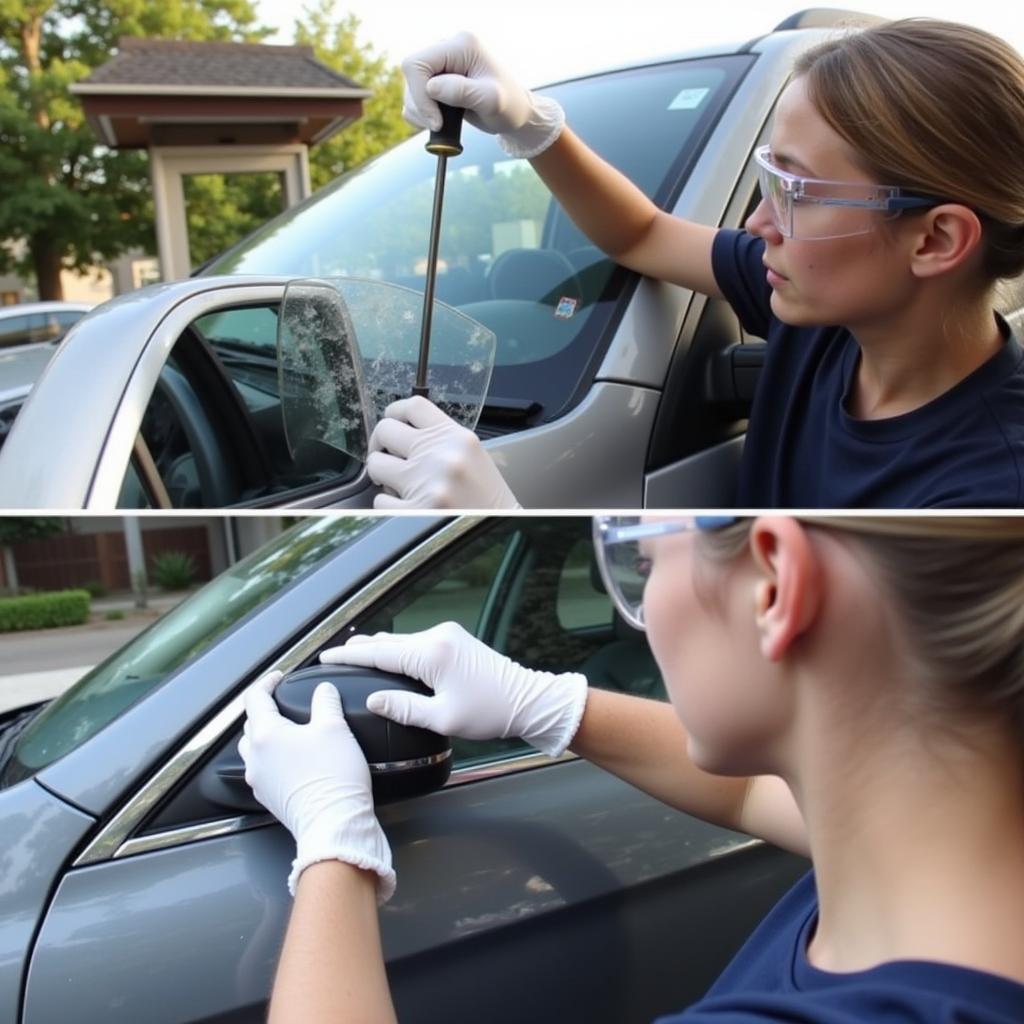A pinhole leak in your car radiator can be a real headache. It can lead to overheating, engine damage, and leave you stranded. This guide will provide you with practical solutions and expert advice to help you understand how to address this common car problem, whether you’re a DIY enthusiast or prefer to leave it to the professionals.
Understanding Your Radiator and Pinhole Leaks
Your car’s radiator is a vital part of the cooling system. It circulates coolant to maintain the engine’s optimal operating temperature. A pinhole leak, as small as it sounds, can disrupt this process and lead to serious issues. These tiny holes can be caused by corrosion, vibration, or even road debris impacting the delicate radiator fins.
What Causes Pinhole Leaks in Car Radiators?
Several factors contribute to pinhole leaks:
- Corrosion: Over time, the coolant can become acidic, eating away at the radiator’s metal components.
- Vibration: Constant engine vibrations can weaken the radiator, especially in older vehicles.
- Road Debris: Small rocks and other debris kicked up from the road can puncture the radiator.
- Poor Quality Coolant: Using the wrong type of coolant or neglecting to change it regularly can accelerate corrosion.
- Electrolysis: Stray electrical currents can cause pitting and corrosion within the radiator.
How to Diagnose a Pinhole Radiator Leak
Before you can fix a pinhole leak, you need to confirm that’s the problem. Look for these telltale signs:
- Low Coolant Levels: If you’re constantly topping off your coolant, it’s a strong indicator of a leak somewhere in the system.
- Overheating Engine: A leaking radiator can’t effectively cool the engine, leading to overheating.
- Visible Leaks: Carefully inspect the radiator for any signs of dripping coolant, especially around the fins and seams. A flashlight can be helpful for this.
- Sweet Smell: Coolant has a distinctive sweet smell. If you detect this odor around your car, it’s likely a coolant leak.
- White Smoke from Exhaust: Coolant leaking into the combustion chamber can produce white smoke from the exhaust pipe.
Can I Drive with a Pinhole Leak in My Radiator?
Driving with a pinhole leak can be risky. The leak can worsen rapidly, leading to sudden overheating and potentially severe engine damage. It’s best to address the issue as soon as possible.
How Can I Fix a Pinhole in My Car Radiator: DIY Solutions and Professional Repairs
There are several ways to tackle a pinhole leak, ranging from temporary fixes to permanent solutions.
DIY Methods:
- Radiator Stop Leak: These products can seal small pinhole leaks. Follow the instructions on the product carefully. Keep in mind that these are usually temporary fixes.
- Pepper: In an emergency, black pepper can temporarily plug a small leak. Pour a teaspoon or two into the radiator. This is a very temporary fix, only for emergencies.
- Epoxy or JB Weld: For slightly larger pinholes, you can try using epoxy or JB Weld to seal the leak. Clean the area thoroughly before applying.
Professional Repair Options:
- Radiator Repair: A professional mechanic can often repair a pinhole leak by patching or soldering the radiator.
- Radiator Replacement: If the damage is extensive, replacing the radiator might be the most cost-effective solution.
“Regular maintenance, including coolant flushes and inspections, is key to preventing radiator problems. Catching issues early can save you money and headaches down the road.” – John Miller, ASE Certified Master Technician
“Don’t underestimate the importance of using the correct type of coolant for your vehicle. Using the wrong coolant can lead to corrosion and leaks.” – Sarah Johnson, Automotive Engineer
Conclusion: Addressing Your Pinhole Radiator Leak
Addressing a pinhole leak in your car radiator is crucial to preventing further damage to your engine. Whether you opt for a DIY solution or seek professional help, understanding the causes and solutions outlined in this guide will help you make the best decision. Don’t let a small pinhole turn into a major engine problem. For further assistance or expert advice, feel free to contact us at AutoTipPro at +1 (641) 206-8880. Our office is located at 500 N St Mary’s St, San Antonio, TX 78205, United States. How can I fix a pinhole in my car radiator? We can help!
FAQ
- How long can I drive with radiator stop leak? Radiator stop leak is a temporary fix and should not be considered a permanent solution. It’s recommended to have the radiator properly repaired or replaced as soon as possible.
- How much does it cost to fix a pinhole leak in a radiator? The cost can vary depending on the severity of the leak and whether the radiator needs to be repaired or replaced. A repair can range from $50 to $200, while a replacement can cost between $200 and $800.
- How do I know if my radiator stop leak worked? Monitor your coolant levels and check for any further leaks. If the coolant level remains stable and you don’t see any more leaks, the stop leak may have been successful, at least temporarily.
- Is it hard to replace a car radiator myself? Replacing a radiator can be a moderately challenging DIY project. It requires some mechanical skills and tools. If you’re not comfortable working on your car, it’s best to leave it to a professional.
- Can a pinhole leak cause my car to overheat? Yes, even a small pinhole leak can cause coolant loss, leading to engine overheating.
- What type of coolant should I use in my car? Consult your vehicle’s owner’s manual for the recommended coolant type. Using the wrong type can damage your cooling system.
- How often should I flush my radiator? It’s generally recommended to flush your cooling system every 24,000 to 36,000 miles or every two to three years, whichever comes first. Consult your owner’s manual for specific recommendations for your vehicle.






Leave a Reply